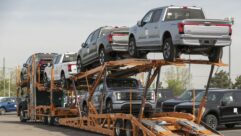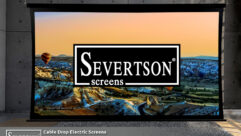Coming Home
Nov 1, 1999 12:00 PM,
Jack McLean
Designing and installing a powerful, intelligible sound reinforcementsystem for the new Cleveland Browns Stadium and the fans who eagerlyawaited the return of their football team.
The Cleveland Browns are back, thanks in part to a beautiful new73,200-seat stadium complete with a host of first-class amenities,including well-conceived and executed sound reinforcement systems. TheBrowns, one of the most storied franchises in the National Football League(NFL) for more than 40 years, effectively left Cleveland in 1995 when thefranchise owner received a lucrative stadium package to transfer the teamto Baltimore. Nevertheless, the team name and distinctive uniforms remainedthe property of Cleveland, and the NFL promised that an expansion franchisewould be awarded to the city with construction of a new stadium.
Already in the midst of an impressive downtown renaissance that hasresulted in the construction of new professional baseball and basketballfacilities in addition to the Rock `n Roll Hall of Fame and otherstructures, Cleveland responded quickly. Designed by HOK Sports FacilitiesGroup, the new Cleveland Browns Stadium, completed in time for the returnof the team during the 1999 football season, is a glass, steel andstructural concrete monument to the city’s grit and determination and theirundying devotion to the Browns.
The stadium, designed primarily for football but also capable of hostingsoccer matches and other large-scale events, was built at an estimated costof $283 million. The city oversaw the two-year construction process andmanaged funding, raised from a variety of public sources. Well into thisprocess, the NFL selected the team’s new ownership from a field ofcandidates, which is now in charge of stadium operations.
Located at the site of its predecessor, Municipal Stadium, on the banks ofLake Erie, careful consideration went into the facility’s integration withits downtown surroundings. Gaps in the seating bowl allow visitors on theoutside to view the field and inside of the stadium, and in turn, the sameopenings allow fans to see the downtown skyline. The north concourse,meanwhile, offers a view of the lake, the nearby North Coast Harbor and theshipping activity at the Port of Cleveland. Even the facility’s name isunique in this day and age of corporate sponsorship, remaining true to thecity and team rather than being auctioned off to the highest bidder. (Thinkof 3Com Park, Cinergy Field or Bank One Ballpark.)
Multilevel seating decks surround the playing surface, broken only by thegaps between the south concourse and each end zone seating section. Theprimary seating levels on the concourses are separated by 148 luxury suitesand 8,600 club seats, while both end zones offer one large seating section,each backed by Daktronics ProStar video screens measuring 279 949 (8.2 m28.7 m). The entire east end zone is dedicated as the Dawg Pound, an areareserved for the most voracious Browns fans who often don dog masks andshow their approval for the team by barking and showering the field withdog biscuits. Other amenities include two large club lounges in the northand south concourses, as well as a Browns hall of fame, restaurant and teamshop.
Bidding process
Sound Com Corporation, a leading sound, video and security systemsintegration firm based in Berea, just outside of Cleveland, spent severalmonths implementing a range of sound reinforcement systems at the stadium,providing not just installation but a wide range of value-added engineeringservices. Specification of these systems was formulated by WrightsonJohnson Haddon & Williams (WJHW), Dallas.
In mid-1998, Sound Com, along with several other systems firms, was askedto supply a bid for their services. These bids, however, were submitted aspart of the overall electrical contracting package, made up of eightdifferent divisions. Ultimately, the electrical contracting bid as a wholewas rejected by the city with all systems integrators asked to tenderindividual proposals. Sound Com emerged from this process as the winnerwith its work commencing in the fall and spanning the next several months.
A trio from the company led the systems effort, interfacing with both WJHWon crucial design issues and the various contractors and construction crewsinvolved with the project.
The team included system integration specialists Simon Davis and R. DaveKocias, as well as support engineers Brendan Dillon, George Lentz and BrianZaremba, who, in addition to supervising on-site installation, deployed anumber of innovative custom engineering solutions.
In brief, the WJHW specification called for a distributed soundreinforcement system to cover the stadium bowl with vocal intelligibilitygiven top priority. A wide range of systems, many of them 70 V, needed tobe deployed in concession areas, restrooms, clubs, press facilities andother spaces, and all of these systems needed to be centrally controlledfrom the sound booth, located on the suite level in the south concourse.
Special assistance
>From the outset, the harsh elements of Cleveland were of concern to SoundCom. Dramatically varying temperatures and constant moisture from the lake,as well as the more than occasional driving rain and snowstorms, needed tobe accounted for with regard to the loudspeakers covering the bowl.Although some options already existed, none of these met the performancestandards called for in the design specification.
“Maintenance is a big issue in a project like this,” said Davis. “Some ofthe speakers in the bowl are very hard to access after installation, andbesides, they should be designed to last as long as possible as a benefitto the customer. We did a lot of investigation but could not find certainmodels the project required offering the proper performance criteria whilealso being extremely impervious to the weather.”
Sound Com found a willing partner, Community Professional Loudspeakers, tohelp address this issue, based on the company’s recently introduced WETloudspeaker series. Working with Community’s Bruce Howze and John Wiggins,several custom WET loudspeakers were devised to meet all environmental andperformance parameters. In fact, the result proved so good that Communitysubsequently developed an entire line, called the Custom WET series,incorporating the elements first defined with this project.
Custom WET series loudspeakers, available in four sizes, are crafted ofhand-laminated fiberglass that is also used for the driver baffles. Systeminstallers have a choice of two-way, three-way and low-frequencyloudspeakers with passive or electronic crossovers, as well as a choice oflow-, mid- and high-frequency drivers, along with a choice of customdispersion patterns. Drivers constructed of weather-resistant materials areanother choice, and in a neat trick of engineering, Community used theproperties of these materials to enhance acoustical performance rather thanhaving them be a deterrent. Additional design variations include choices ofenclosure orientation, heavy-duty rigging points and custom colors for thecabinet and grille.
“This is the first time that designers and installers have the choice ofconfiguring a weatherproof system to their specific parameters. Theenclosure size chosen determines both the low-frequency performancecapabilities of the system and the range of pattern control offerings,”said Howze. “The carbon fiber used for midrange cones and woofers offersuperior strength-to-mass ratios, while the polyimide used in thehigh-frequency diaphragms offers excellent flexural strength, resulting invery good sonic characteristics.”
Davis said, “We’re employing two models at the stadium, one for loweroutput needs and the other for higher output requirements, and both workextremely well. In short, we’re very glad we approached Community.”
Another valuable contributor from the manufacturing side was Crest Audio.All power amps for the project are Crest, under NexSys control. As themyriad amp racks for the various systems were being assembled at SoundCom’s facility prior to installation, Crest provided consultation and alsoarranged for one of its technical staff members to check each rack inperson, verifying all configurations, wiring and connections.
Totally distributed
“The number one priority for the bowl system is intelligibility, whichnaturally lends itself to a distributed approach,” said Dillon. “On thisproject, it’s reasonable to estimate that the furthest distance aloudspeaker has to cover is about 50 feet (15.2 m), less in most cases.”
Mounting the hundreds of loudspeakers safely and effectively requiredfabrication of a variety of custom brackets, which Sound Com developed withCaravan Industries of Elyria, OH. “Safety was again our number one concern,along with resistance to the elements,” Davis said. “This process was alsomore challenging than usual because some of the loudspeakers beingdeveloped for the project weren’t even finalized yet.”
Sound Com also elected to go beyond the specification on several accounts,most notably in terms of the amount of rotation of each loudspeaker thebrackets would allow. The spec called for 5degree rotation; the end resultoffered 45degree.
Dillon said, “We felt the added flexibility was needed, first, because someof the loudspeakers weren’t complete, second, for more precision in aiming,and finally, for easier maintenance. In fact, some of the loudspeakers onthe lower levels can be rotated back far enough for servicing from theaisle without need for a ladder or scaffold.”
Upper-level seating on both north and south concourses is covered by groupsof three loudspeakers in custom brackets mounted to the rear canopy. Oneloudspeaker fires forward; the second is aimed almost straight down, andthe other fires to the rear. The vast majority of these loudspeakers arePeavey Electronics Impulse 200s, offering a compact two-way design withexceptional weatherproof capabilities. These groups are mounted for optimumcoverage of specific seating sections, given each loudspeaker’s 90degree45degree coverage pattern. Every other group substitutes a compact WETseries model 322 loudspeaker for front-firing coverage, where more outputwas needed to reach select lower-level seating zones.
Coverage to the majority of club seats on the concourses is supplied bysingle Custom WET series model 315 loudspeakers mounted to the face of theupper level; in other words, they are directly behind these seating areas.Spaced about 25 feet (7.6 m) apart, these loudspeakers originally were tobe mounted horizontally, with the cabinets including dual 12 inch (305 mm)woofers. Conflicts with signage necessitated that they be mountedvertically with their horns rotated and a single 15 inch (381 mm) wooferreplacing the dual 12 inch woofers, giving the enclosures a lower profile.
Shadowed areas immediately beneath these loudspeakers receive coverage fromeither Renkus-Heinz (R-H) TRC61W (south concourse) or TRC81W (northconcourse), both compact two-way loudspeakers that are mounted horizontallyand fire almost straight down. Open-air luxury suite seating immediatelybehind this area are each served by dual JBL Control 28 loudspeakers.
Finally, the lower level of the bowl features tandem coverage from CustomWET series model 322 loudspeakers and Impulse 200s. These two models, againon custom brackets and attached to the face of the club level, arealternated. Model 322s supply longer-throw coverage, while the Impulse 200shandle nearfield, firing almost straight down, with the zones covered bythe two feathered together for smooth coverage without hot or dead spots.
Both end zones have virtually identical loudspeaker packages. ThreeCommunity FCH6051 mid-high loudspeakers are paired with three Community R6low-frequency systems (all weatherproofed), mounted atop the video boardstructures behind the seating sections. The R6 uses six 12 inch (305 mm)drivers in a unique manifold configuration for long throw and high output.These combos cover the upper portion of each end zone, while the lowersection is blanketed by another WET series model 322 and Impulse 200pairing, used in the same manner as they are on the concourses.
“All of these loudspeakers were ideal for this application,” said Kocias.”They offered the prerequisite resistance to the elements and placed apremium on vocal intelligibility. You certainly don’t have any problemunderstanding what is being said.”
Driving components
Close to 150 Crest power amps, all housed in Middle Atlantic racks, drivethe bowl system. These racks are distributed among six secured roomsthroughout the club level of the stadium. Crest CKS series amps handle mostof the loudspeakers, generally driving 4 V loads. Crest 9001s are deployedfor low-frequency sections of the higher output WET series loudspeakers. Asmentioned, all power amps are under Crest NexSys control, with its version3.0 software, implemented and tailored for this application by Sound Com,hosted on a Dell Dimension PC in the sound booth.
“We have been extremely pleased with NexSys on this project,” Dillon said.”All amplifiers are sequentially turned on and off, and we can view andmodify this from the control position. In addition, having access to levelcontrol and status indicators really saves a lot of walking around. We knowwhat every amp is doing any time we choose to take a look.”
Signal processing of the bowl system is done in the analog realm. “It’scertainly been popular to use digital processing mainframes in stadiumsystems, but we have some apprehensions about that approach,” Davis said.”It seems that sometimes all of the capability they provide can actuallycomplicate the system too much. Sometimes more is not necessarily better.Plus, you’re placing a lot of faith in one single unit, and if it fails,you can get into trouble without options.”
As a result, White Instruments 5024 crossovers and Klark-Teknik (K-T)DN7204 delays form the heart of signal processing for the bowl system,housed in the sound booth. Both units also include equalization; the Whiteunits supply overall equalization while the K-T units are used for moreindividual tailoring and tweaking by zone. Further equalization, as well aslevel adjustment, is accomplished on the Soundcraft K2 mix desk establishedfront/center in the booth. Two Crown CM-311 headset mics for PAannouncement purposes, are first routed through Symetrix 528E vocalprocessors for optimization.
Two 360 Systems DR-522-16 digital playback machines supply recordedmessages to the bowl system, as well as to many of subsidiary systemsthroughout the facility. A Click Effects hard drive system supplies variousaudio playback and sound effects, while Marantz CD and cassette players canalso be used. An audio feed from the adjacent video control room, whichaccompanies programming shown on the video screens, is kept consistent witha Symetrix 425 compressor/limiter.
“We’ve even put a delay channel on the Mackie monitor speakers in the boothso that they are in sync with the bowl system when the window of the boothis open,” Kocias said. “The system operators really appreciate this.Overall, the booth is set up pretty well with anything that the operatorsmight need right at their fingertips, and in essence, they shouldn’t haveto do much with the system through the course of a game besides verifyingthat the everything is operating properly and occasional minor adjustments.”
Another facet of the bowl system is the ability to put a pretty impressivearray of equipment on the field for pre-game and halftime festivities.Sound Com created several custom panels that can accommodate severalCommunity XLT48E monitor wedges in addition to 48 mic jacks all directlylinked back to the console. Two Vega R-662A UHF wireless systems are alsoavailable with antennas and receivers mounted in a rack in the booth. Fourchannels of the house-wide Clear-Com intercom system can also be accessedon the field, and this is interfaced with a Telex RTS system used by thevideo production crew. The intercom system is also accessible at all remoteequipment rooms.
Ancillary work
Just the equipment list for the project spans more than 10 pages in length,and it serves as a good indicator of the sheer amount of systems work thatSound Com poured into the project. Hundreds of ceiling loudspeakers, fromsuch manufacturers as Lowell, Atlas and OWI, serve a host of common areassuch as concession stands, restrooms, gates – in short, it is virtuallyimpossible to be out of reach of paging announcements and otherprogramming. It’s all driven in 70 V mode by Crest CKV power amps also onthe NexSys control bus and located with the bowl system amps at severalstadium locations.
Sound Com deployed a Peavey MediaMatrix MM740 Mainframe to provide allprocessing for these systems, in addition to establishing an impressivelyflexible signal routing scenario. Located in the sound booth, MediaMatrixshares the Dell PC with the Crest NexSys amp control software, done in theinterest of space savings and ultimately an arrangement that has proven tofunction in a satisfactory manner.
“With the way we’ve set up the MediaMatrix, we can send independent signals- all optimally processed – to more than a dozen subsystems servingdifferent zones and areas. You select the source material and where youwant it to go, click, and it’s done,” said Dillon.
All source feeds, such as the PA announcements, home radio broadcast and TVbroadcast are all routed to AMX Axcent3 integrated controllers, in turnlinked to AMX touchpanels in both club lounges. This provides club hoststhe opportunity to select any source to be played in the club, or, they canchoose to play music on a local Denon DCM-60P CD player. Mic panels inthese rooms allow localized presentations to be held as well.
All restroom and concession area systems have time delay parametersprogrammed into their feeds from MediaMatrix, ensuring that they are insync with the bowl system. Sound Com also established auto gain riding inthe software, which automatically adjusts the level of these systems inrelation to the output of the bowl. Line-level source signals to thefurthest of these ancillary are transported via fiber optics, with BECTechnologies SigmaNet A/D and D/A converters carrying 10 channels.
Two press conference/interview rooms have their own discrete systemelectronics feeding ceiling loudspeakers. In both cases, they include TOAM-900MK2 automatic mixers linked to several mic jacks in the room, withseveral remote volume controlsinstalled on the walls. The press room,ensconced on the club level is served by its own independent system, with aPeavey A/A-8P mic line preamp feeding a Phonic Ear PE550T FM base station.It provides RF signals to up to 48 PhonicEar 300RS receivers available tomembers of the press – anyone wanting the press feed gets it withoutdisturbing others working in the location.
Final phase
Sound Com’s aggressive preparation and adherence to a strict systemimplementation schedule paid off in the end with the system installed,completed tested and optimized well prior to the kickoff of the 1999season. The tuning process commenced with verification of all ancillarysystems – not an easy task. After every single loudspeaker was determinedto be working properly and then set to proper levels, it was time to moveon to the bowl system.
WJHW and Sound Com teamed up for this portion of the project, using a TEF20 analyzer to aid the process. “We had already roughed in the settingsestablished in the spec, and had also done some preliminary test andanalysis, so the final tuning process was just a matter of tightening andtweaking,” Dillon said. Time delay was established with one of the primaryend zone arrays serving as point zero, or the reference point to whichevery other bowl loudspeaker was set.
“One of the most notable things about the design is that energy is kept offthe field to a large degree. In fact, we’ve received compliments on howquiet it is down there,” Davis said. “The crowd is normally at about 85 dBwith 103 dB peaks. As a result, we run the system at 92 dB to 95 dB most ofthe time, and then just bring it up when necessary. At any working level,we’ve found the system to be highly coherent and intelligible, so theprimary performance criteria has been met and exceeded.”










